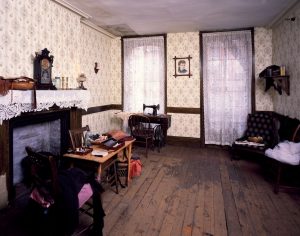The Housing Problem
The construction of Tenements was utilized for housing working immigrants, domestic citizens and their families. With millions of new immigrants flocking to major cities across the United States, housing problems became some of the major consequences of such an event. Tenements during the early 20th century are not houses, in fact they are apartment-like buildings housing many families in each one, and were usually in bad shape. The housing problem in New York city was initiated due to the herding of men and women together under conditions which inevitable tend to produce disease and crime (DeForest and Veiller, 1903. 3).
Parlor at the New York City Tenement Museum, New York, 1946.
This 1946 photograph illustrates the small, compact living arrangements inside a standard tenement in New York City. Captured is an example of what a parlor, or living room, was comprised of. In the back left of the photo one can see a sewing machine with some sort of cloth next to it. This is a great illustration on the recurring theme of work at home. Meaning that work done between the usual hours of 9-5 pm is then continued at home, so the sense of relaxing at home after work is not evident in tenement housing. This photograph depicts one of the nicer tenements in the New York city area, as opposed to tenements lacking proper air flow and light.
“Homes of the poor”, drawn by T. De Thulstrup, 1883
This newspaper cover drawn by T. De Thulstrup in 1883 clearly illustrates the overcrowded living in tenements. The tenement housing problem can be explained through analyzing this drawing. In the drawing there are twelve people and assuming that they all live together, one may think that this is unfit at any rate. With city rents increasing by the year, living alongside many other people can be a way of minimizing the income required by each member per rent period. The housing problem erupted due to the lack of legislation and efforts to stop citizens from overcrowding their living quarters. In 1900, a five room tenement had an average rent price of $23 and the prices for smaller tenements (four, three, two rooms) decreased until an average rent of two rooms at $8 (Streightoff 1911). Based on this assessment, families would have to devote approximately 25% of the incomes on housing (Streightoff 1911), which is quite a lot considering the living conditions
“Our Religious Landlords and their Rookery Tenants”, Taylor, C.J., print, (1895).
This print was found on the Library of Congress database. Charles Jay Taylor created this print and it was published by Keppler & Schwarzmann on January 9, 1865. The intention of this print is to illustrate the relationship between landlords and their tenants. Included in the print, on both sides, are tenement houses and those who live in them. The purpose is to possibly explain the ongoing differences and challenges that poor tenants faced in contrast to the few challenges that their landlords experienced. The background of the print is the Trinity Church in New York City and the landlords seem to be exiting this church. And on either side are some irritated citizens, tenants, who can be depicted as a far lesser social and economic class than the people in the center of the print. This idea is prevalent in many large cities across the United States, but New York city stands out due to the large numbers of tenement housing. This print benefits the illustration of my exhibit in showing the tenement housing problem and its’ effects on the families living in them.
Notes:
– Highsmith, Carol M, photographer. Parlor at the New York City Tenament Museum, New York. New York New York State New York. United States, None. [Between 1980 and 2006] Photograph. https://www.loc.gov/item/2011635004/.
– Detroit Publishing Co., Publisher. Exterior of tenement, New York City. New York New York State New York. United States, None. [Between 1900 and 1910] Photograph. https://www.loc.gov/item/2016812574/.
– Thusltrup, T. De. Homes of the poor, New York, 1883. Photograph. https://www.loc.gov/item/96506806/.



